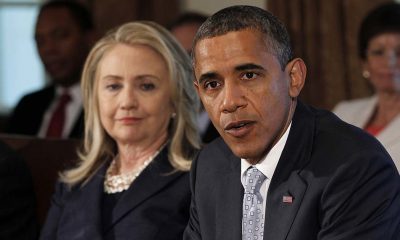World
No charges against white officer for killing unarmed black man

Washington: Yet another white police officer who shot and killed an unarmed black teenager in March in one of a spate of similar incidents sparking protests around America will not face criminal charges.
Tony Robinson Jr, a 19-year-old black man was fatally shot by white police officer Matt Kenny in Madison, Wisconsin, on March 6, setting off days of protests in the city amid tensions over several such previous incidents. There have been at least 14 major instances of a white policeman shooting dead a black person since 17-year-old Trayvon Martin was fatally shot on Feb 26, 2012 in Sanford, Florida. And in all of them policemen have gone scot-free.
Baltimore, near Washington, which last month erupted in riots and violence last month over the death of Freddie Gray, a 25-year-old black man in police custody, was different from other incidents in that six involved police officers have been charged there.
Dane County District Attorney Ismael Ozanne announced Tuesday that he had concluded “that this tragic and unfortunate death was the result of a lawful use of deadly police force and that no charges should be brought against Officer Kenny”
While the Wisconsin Professional Police Association welcomed the decision not to charge Kenny, it drew swift criticism from several of Robinson’s family members with his grandmother, Sharon Irwin saying “This is politics, and not justice.”
Robinson’s mother Andrea Irwin said her family “absolutely” plans to file a civil lawsuit against the Police Department and alleged: “They have done a smear campaign against my child and against me since this all began.”
Robinson’s family has hired a Chicago law firm to carry out its own investigation into the shooting and commissioned a private autopsy, according to the Wisconsin State Journal.
Attorney Jon Loevy said Robinson’s family supports protests over the case, but stresses they should not be violent.
Near the site of the March shooting, demonstrators held a large banner Tuesday that said, “BLACK LIVES MATTER” and chanted, “No justice, no peace, no racist police.”
Noting his own background as the first district attorney of colour in the state, Ozanne told reporters: “My decision will not bring Tony Robinson Jr. back.”
“My decision will not end the racial disparities that exist in the justice system, in our justice system,” he was quoted as saying by CNN.
“My decision is not based on emotion. Rather, this decision is based on the facts as they have been investigated and reported to me.”
Ozanne said txicology reports confirmed that Robinson had taken hallucinogenic mushrooms, marijuana and Xanax before the shooting and 911 calls reported that he was acting “insane” and attacking people.
Kenny who called to an apartment over reports that Robinson had been jumping in front of cars and assaulting people, claimed that Robinson hit him and knocked him into the wall inside the apartment.
After that, Kenny said he was afraid Robinson would hit him again or take his gun, and opened fire as the 19-year-old continued to come at him.
In three seconds, seven shots were fired. All of them hit Robinson at close range, Ozanne said.
Kenny has been on paid administrative leave since the shooting. That status will continue, the police chief said Tuesday, while the department completes an internal policy review of the incident.
The Police Department has said it prepared for the prosecutor’s announcement for weeks and hoped to avoid violence and property damage.
World
Lockdowns in China Force Urban Communities to Defy Censorship and Vent Frustration Online

Shanghai’s rich middle class is leading a wave of online dissent over the strict and prolonged lockdowns imposed in various parts of the country. Chinese internet censorship is struggling as patience is wearing thin in many urban centers, coming up with creative forms of online protests.
Social Media Posts Revealing Lockdown Tension in Shanghai
Drawn-out lockdowns are nothing new in China as authorities insist with the nation’s zero-Covid policy since the start of the pandemic. Currently over This time around, however, metropolitan areas like Shanghai are increasingly difficult to keep quiet, given that its more than 25 million residents have seen weeks of total isolation along with food shortages and many other service interruptions.
Dozens of towns and reportedly over 300 million Chinese citizens have been affected by lockdowns of different severity. As expected, urban netizens have been most outspoken over their difficulties by finding creative ways to get around state censorship and bans placed on topics, news comments and spontaneous campaigns.
Shanghai residents have been using mobile proxies and hijacking seemingly unrelated hashtags to talk about healthcare issues, delivery failures and the overall severity of their situation. The “positive energy” that the Chinese government wants to transmit during the recent prolonged series of lockdowns does not come naturally to those counting food supplies and online censors are working hard to filter words, trending topics and undesired social media sharing.
WeChat groups and message threads are under constant monitoring. Posts questioning the zero-Covid approach have been quickly deleted, including by leading Chinese health experts like Dr. Zhong Nanshan. Video footage is soon censored and protests and investigations are quickly made to disappear.
Where this has not worked, officials have exposed banners with warnings and outright threats like “watch your own mouth or face punishment”, while drones have been patrolling the city skies. Yet, if anything, this has led to further tensions and unspoken confrontation with Shanghai’s educated and affluent middle class.
Creative Online Solutions Harnessing Civic Energy
Announcements by Chinese social media that they would be publishing the IP addresses of users who “spread rumors” have not helped either. Tech industry research has shown that much of Asia’s tech-savvy population has a habit of using mobile proxies and other privacy tools, quickly finding workarounds to browse the internet freely and talk to the world about the hottest topics.
The sheer volume of forbidden posts is already a challenge for the very censorship system, experts explain. Unable to track all trending hashtags, state workers overlook topics that speak about the US, Ukraine or other popular news. Linking human rights elsewhere to their situation, Chinese online dissidents establish their informal channels and “hijack” the conversation to share personal or publicly relevant information about the Covid suppression in their town.
Sarcastic and satirical posts still dominate. Others hope to evade the censors by replacing words from famous poems or the national anthem. One thing is certain – social media, when harnessed with the right creativity, has proven its ability to mount pressure on the government in even some of the most strictly controlled tech environments like China.























